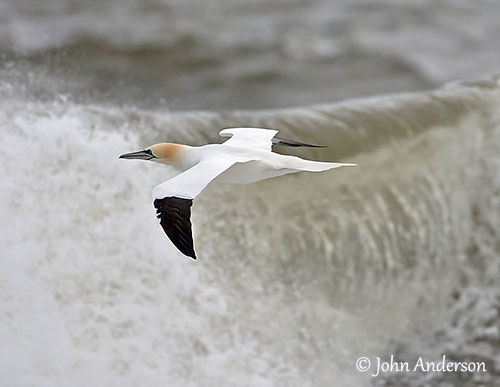
See also:
The card: Northern Gannet
The article: Family Sulidae
Photographer:
John Anderson
John Anderson Photo Galleries
These images and the text are subject to copyright and cannot be used without express authorization from the owners. Legal issues
Text by Nicole Bouglouan
Sources:
HANDBOOK OF THE BIRDS OF THE WORLD vol 1 by Josep del Hoyo-Andrew Elliot-Jordi Sargatal - Lynx Edicions - ISBN: 8487334105
Wikipedia, the free encyclopaedia
The Birds of North America online
The Guardian - Gannets flight tracked in real time for the first time via 3G
OCEANWIDE Expeditions - Northern Gannet
Windscape and tortuosity shape the flight costs of northern gannets
Nature Canada - The Northern Gannet – majestic in flight and raucous on land
The Northern Gannet, an acrobat in the sky
Flying like a bird has always been a human’s dream. Since the beginning of aviation, development has continued to increase with varying degrees of success. But at least, humans were finally able to fly in the blue sky!
But that is nothing beside the agility of the Northern Gannet in flight…
The Northern Gannet is a large seabird of almost two metres of wingspan. This white bird spends most of its time at sea, and only comes on land for nesting.

This elegant bird is clumsy on land. Take off requires a running start, and for this reason, the breeding colonies are usually established high up on steep coasts, often on sea cliffs where the wind is forced upwards against the rocky wall. The bird only needs to spread the wings to take off.
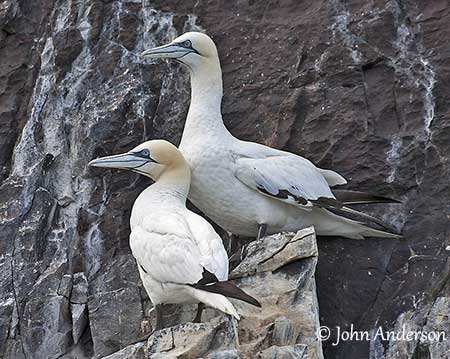
The Northern Gannet has cigar-shaped body and fairly long, wedge-shaped tail. The long, narrow, pointed wings are quite far back on the body. They allow the bird to cruise along in strong wind, but they are primarily designed to take part in the specialized fishing behaviour of the members of family Sulidae.
In normal flight, the Northern Gannet performs powerful wingbeats interspersed with glides. It also uses dynamic soaring in high winds.
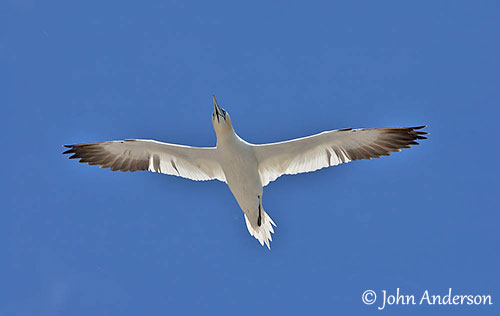
The Northern Gannet takes off from high cliffs after a running start and then, it spreads the wings and rises into the air, thanks to the upwards winds. The long wings allow efficient use of air currents during the flight, and these birds may reach a speed of 55/65 km/hour in calm weather.
To alight on land, the wings are angled and the tail is fanned, while the webbed feet are raised in order to control the speed.
This is the flying behaviour of the Northern Gannet when the bird is nesting and needs to come on land.
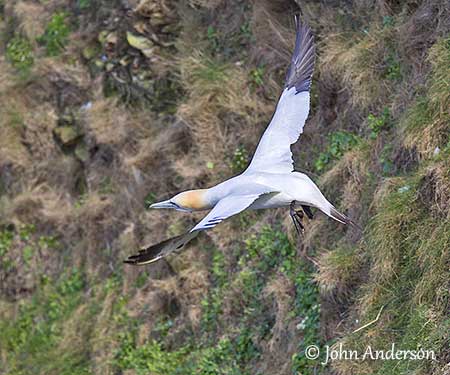
But the Northern Gannet and other members of family Sulidae are really “at home” both in the air and at sea.
As these birds are highly aerial and feed at sea, they are known for their typical “plunge-diving” behaviour, often from great heights. They usually fly higher than other seabirds when foraging. They generally plunge from 10/30 metres up. The prey is located thanks to the binocular vision.
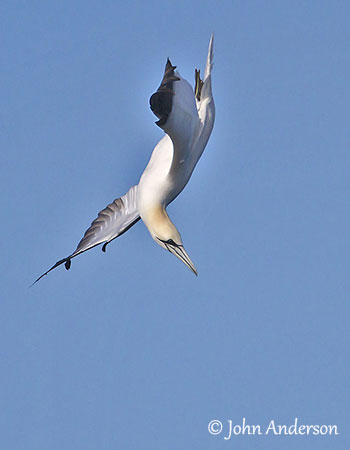
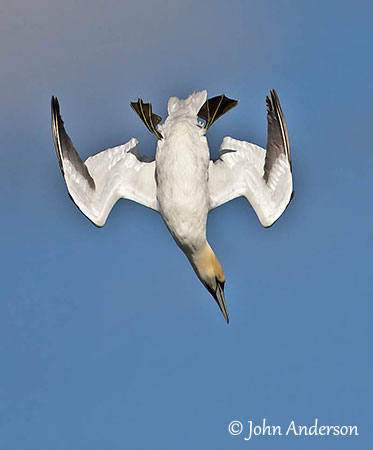
The gannet often stalls before to dive, adjusting direction while descending. The bird plunges headfirst into the water at top speed. The wings are pushed backwards until being parallel to the body. They may appear completely “broken” at this moment.
The Northern Gannet is able to reach depths of 10 metres, only with the impulse of the dive. But it also uses its wings underwater to descend deeper, to 15 metres or sometimes 25 metres down.
The fish is usually caught when the bird is on its way up again, and the prey is often swallowed underwater except for the largest food items.
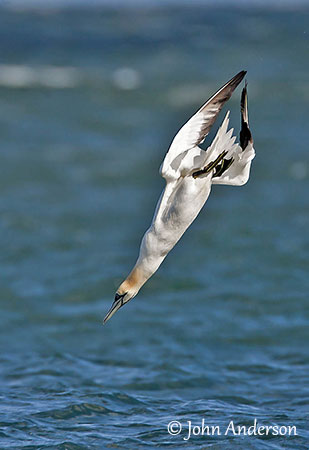
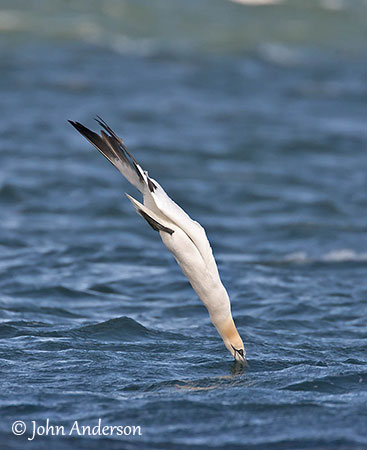
In order to take off from sea, the bird requires a short run along the water surface, but the wind may also help it to rise into the air.
However, after a very heavy meal, or in absolutely calm weather conditions, the Northern Gannet may have sometimes to wait several hours before to be able to take off.
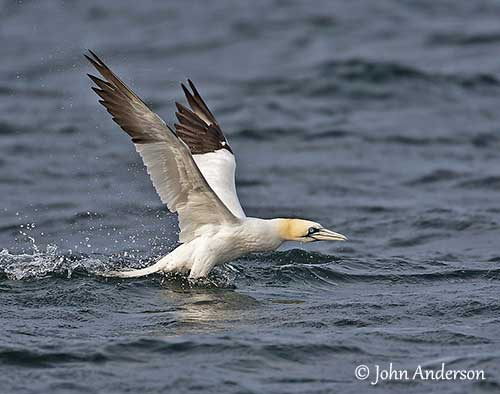
Landing on the sea needs a dive in from low down, but the bird may also glide low over the water, then spreading its webbed feet and the tail downwards before settling on the surface.
On land, landing is often clumsy and may even result in accidents.
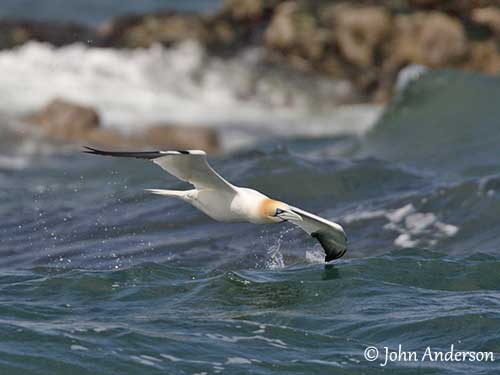
The Northern Gannet often forages in flocks, and the birds may appear like a white rain while plunging in unison into the water.
Sulidae are handsome seabirds and traditionally the object of human’s admiration.
The Northern Gannet is the symbol of marriage between wind and sea for numerous poets, and this species deserves it!
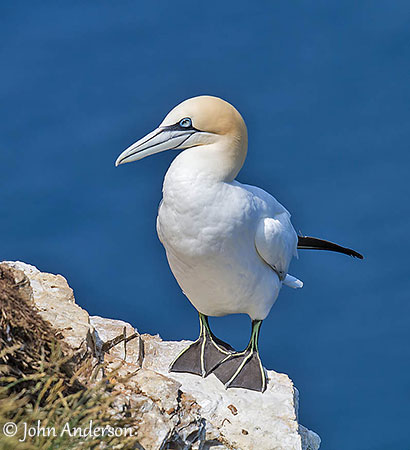
Page sous
copyright!
Page under
copyright!